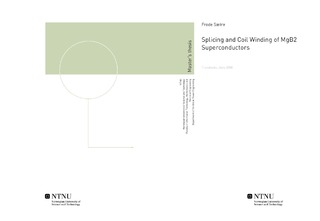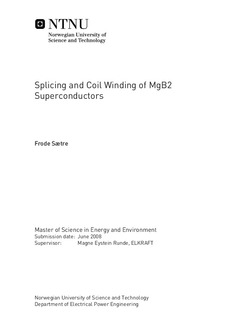| dc.contributor.advisor | Runde, Magne Eystein | nb_NO |
| dc.contributor.author | Sætre, Frode | nb_NO |
| dc.date.accessioned | 2014-12-19T13:51:10Z | |
| dc.date.available | 2014-12-19T13:51:10Z | |
| dc.date.created | 2010-09-04 | nb_NO |
| dc.date.issued | 2008 | nb_NO |
| dc.identifier | 348619 | nb_NO |
| dc.identifier | ntnudaim:4158 | nb_NO |
| dc.identifier.uri | http://hdl.handle.net/11250/256585 | |
| dc.description.abstract | Abstract Conventional induction heaters for extrusion purposes have an efficiency of only 55 60 % due to the resistive losses in the copper coils putting up the magnetic field. By using superconductor and DC current these losses can be minimized and the overall efficiency can be increased to as much as 90 %. DC current requires a new design of the induction heater were the billet has to rotate with the magnetic field perpendicular into the billet. A 200 kW induction heater is to be build by using the superconductor MgB2 which was discovered in 2001. The heater consists of two coils with 16 discs in each coil. Each disc has 75 turns inwards and 75 turns outwards with a total length of 550 metres wound in two layers. The operating temperature in the coils is 20 22 K and the current is 200 A. The discs in the coils have to be joined together in a resistive overlap joint. The joints will generate heat which must be cooled away and will decrease the critical current (highest current the superconductor can conduct). It is important that the joints have low resistance and can be made in fairly reproducible way. A tool to make these joints was therefore made and tested. The overlap joints had a length of 10 cm and had a resistance of maximum 71 nΩ. When increased the force pressing the conductors together the highest resistance was 48 nΩ which will generate 2 mW of heat each if a operating current is 200 A. The critical current was decreased due to the joints. The critical current was found to be 238 A at 30 K and approximately zero magnetic field density. The expected critical current for the joints are approximately 400 A at 25 K. With an expected reduction in critical current of 15 % due to the magnetic field in the joints can still conduct the operating current of 200 A with a large safety limit. To be able to determine the performance of the joints the temperature has to be measured with a certain degree of accuracy. This was a problem in the work with testing the joints and the accuracy of the thermometer itself had to be carried out. The thermometer was the temperature dependency of the resistance in a 0.1 mm copper wire. The deviation from the given resistance ratio increased at lower temperatures and caused a misreading of as much as 5 degrees at 21 K. It was determined that the thermometers are not recommended to use at temperatures below 35 K and that they need a calibration before use at higher temperatures if high accuracy is required. The superconducting tapes are insulated in polyimide film before they are wet-wound in an epoxy with high thermal conductivity. The insulation and winding of these discs have been going on in parallel with the joint testing and the process is described in this report. | nb_NO |
| dc.language | eng | nb_NO |
| dc.publisher | Institutt for elkraftteknikk | nb_NO |
| dc.subject | ntnudaim | no_NO |
| dc.subject | SIE5 energi og miljø | no_NO |
| dc.subject | Elektrisk energiteknikk | no_NO |
| dc.title | Splicing and Coil Winding of MgB2 Superconductors | nb_NO |
| dc.type | Master thesis | nb_NO |
| dc.source.pagenumber | 80 | nb_NO |
| dc.contributor.department | Norges teknisk-naturvitenskapelige universitet, Fakultet for informasjonsteknologi, matematikk og elektroteknikk, Institutt for elkraftteknikk | nb_NO |

